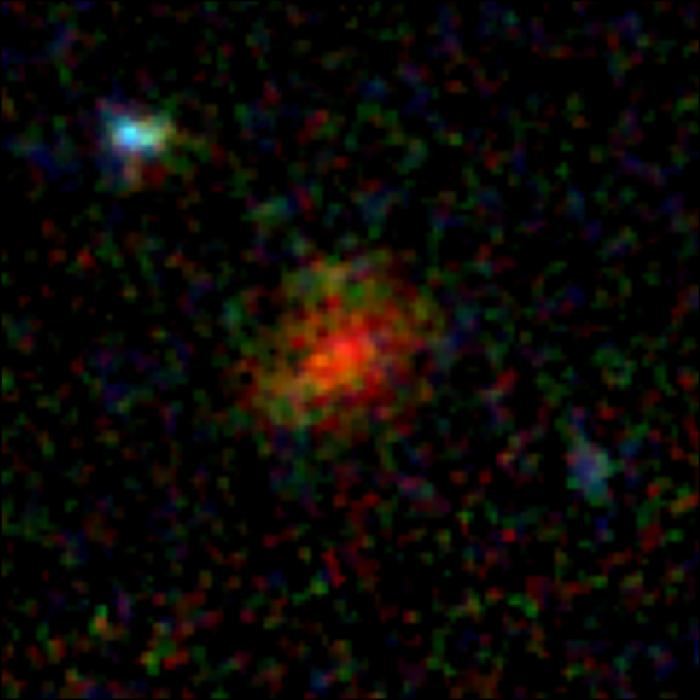Initially emerging as a luminous blob through ground-based telescopes, this enigmatic entity vanished entirely in Hubble Space Telescope images. However, it has recently resurfaced as a faint yet discernible galaxy in a capture from the James Webb Space Telescope (JWST).
 Color Composite of Galaxy Aztecc71 From Multiple Color Filters in the Nircam Instrument on the James Webb Space Telescope. Image Credit: J. Mckinney/M. Franco/C. Casey/University of Texas at Austin.
Color Composite of Galaxy Aztecc71 From Multiple Color Filters in the Nircam Instrument on the James Webb Space Telescope. Image Credit: J. Mckinney/M. Franco/C. Casey/University of Texas at Austin.
The COSMOS-Web collaboration's team of astronomers has identified AzTECC71 as a galaxy characterized by intense star formation, obscured by significant amounts of dust. This galaxy, dating back to nearly 1 billion years post-Big Bang, is part of a category that was previously believed to be scarce in the early universe. However, this discovery, along with over a dozen similar yet-to-be-documented candidates found in the initial data from COSMOS-Web, indicates that such galaxies may be more prevalent than previously thought, potentially three to 10 times more common.
This discovery and more than a dozen additional candidates in the primary half of COSMOS-Web data propose that they might be three to 10 times as common as expected. This is yet to be described in the scientific literature.
This thing is a real monster. Even though it looks like a little blob, it’s actually forming hundreds of new stars every year. And the fact that even something that extreme is barely visible in the most sensitive imaging from our newest telescope is so exciting to me. It’s potentially telling us there’s a whole population of galaxies that have been hiding from us.
Jed McKinney, Postdoctoral Researcher, The University of Texas, Austin
If this conclusion is verified, it implies that the early universe contained significantly more dust than previously theorized.
The team published its findings in The Astrophysical Journal.
The COSMOS-Web project - the largest initial JWST research initiative, co-headed by Caitlin Casey, an Associate Professor at UT Austin - goals to map up to 1 million galaxies from a part of the sky, the size of three full moons. The goal, in part, is to study the initial structures of the universe.
A group of more than 50 scientists was granted 250 hours of observing time in JWST’s first year and received a first batch of data in December 2022, expecting more in January 2024.
A dusty star-forming galaxy is difficult to see in optical light as most of the light from its stars is captivated by a veil of dust and then re-emitted at redder (or longer) wavelengths. Before JWST, astronomers sometimes referred to them as “Hubble-dark galaxies,” about the most sensitive space telescope before.
Until now, the only way we’ve been able to see galaxies in the early universe is from an optical perspective with Hubble. That means our understanding of the history of galaxy evolution is biased because we’re only seeing the unobscured, less dusty galaxies.
Jed McKinney, Postdoctoral Researcher, The University of Texas, Austin
The galaxy, AzTECC71, was initially identified as a hazy emission of dust by a James Clerk Maxwell Telescope camera, working in wavelengths from far infrared to microwave. Subsequently, the COSMOS-Web team pinpointed this entity using ALMA telescope data, which provides higher resolution in infrared wavelengths, allowing for precise localization of the source.
Upon examining JWST data, specifically at 4.44 microns in the infrared spectrum, they discovered a subtle galaxy perfectly aligned with the identified location. Notably, this galaxy remained unseen in shorter wavelengths of light, below 2.7 microns.
Today, the group is functioning to expose additional JWST-faint galaxies.
With JWST, we can study for the first time the optical and infrared properties of this heavily dust-obscured, hidden population of galaxies. Because it’s so sensitive that not only can it stare back into the farthest reaches of the universe, but it can also pierce the thickest of dusty veils.
Jed McKinney, Postdoctoral Researcher, The University of Texas, Austin
The group estimates that the galaxy is being viewed at a redshift of about 6, which is interpreted to be about 900 million years after the Big Bang.
Research authors from UT Austin are McKinney, Casey, Olivia Cooper, a National Science Foundation graduate research fellow, Arianna Long, a NASA Hubble fellow, Hollis Akins, and Maximilien Franco.
The research is funded by NASA through a grant from the Space Telescope Science Institute.
Journal Reference:
McKinney, J., et al. (2023). A Near-infrared-faint, Far-infrared-luminous Dusty Galaxy at z ∼ 5 in COSMOS-Web. The Astrophysical Journal. doi/10.3847/1538-4357/acf614.